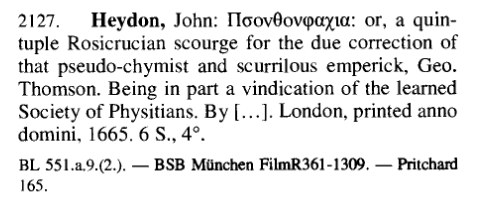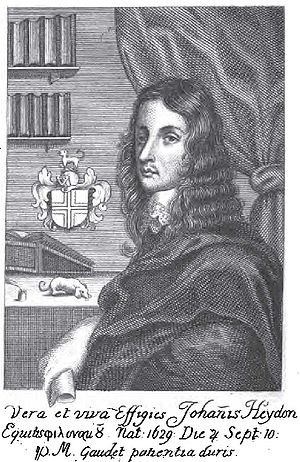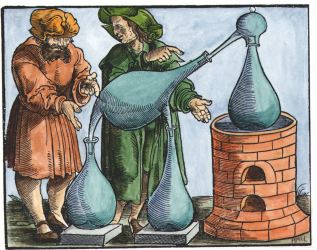| Author | Post |
|---|
Alan Pritchard
Guest
| Joined: | |
| Location: | |
| Posts: | |
| Status: |
Offline
|
|
Posted: Thu May 13th, 2010 03:52 pm |
|
Does anyone have access (via EEBO, or even the original) of John Heydon's "[Psonthophanchia; in Greek]: or, a quintuple Rosiecrucian scourge for the due correction of that pseudo-chymist and scurrilous emperick, Geo. Thomson" ?
I am trying to work back from the transliteration of the Greek word 'Philonomos' following 'J. Heydon Gent'
My question is: Is the final s of the word, the final sigma (ς) or the normal sigma (σ). I hope those come out in this message, but you can see the difference in Word. Unicode codes 03C2 (final) or 03C3 (normal). For a book of that period, I don't think that I can take anything for granted.
Grateful if someone could just clarify this, please.
|
Paul Ferguson
Member

| Joined: | Fri Feb 15th, 2008 |
| Location: | |
| Posts: | 1538 |
| Status: |
Offline
|
|
Posted: Thu May 13th, 2010 10:42 pm |
|
Alan Pritchard wrote:
Does anyone have access (via EEBO, or even the original) of John Heydon's "[Psonthophanchia; in Greek]: or, a quintuple Rosiecrucian scourge for the due correction of that pseudo-chymist and scurrilous emperick, Geo. Thomson" ?
I am trying to work back from the transliteration of the Greek word 'Philonomos' following 'J. Heydon Gent'
My question is: Is the final s of the word, the final sigma (ς) or the normal sigma (σ). I hope those come out in this message, but you can see the difference in Word. Unicode codes 03C2 (final) or 03C3 (normal). For a book of that period, I don't think that I can take anything for granted.
Grateful if someone could just clarify this, please.
Surely Psonthophachia?
|
Tom Willard
Member

| Joined: | Mon May 5th, 2008 |
| Location: | Tucson, Arizona USA |
| Posts: | 96 |
| Status: |
Offline
|
|
Posted: Fri May 14th, 2010 07:55 am |
|
Oddly enough, EEBO has no images from this book, only a citation from the BL catalogue:
1. Heydon, John, b. 1629.
Psonthophachia, or, A quintuple Rosie-crucian scourge for the due correction of that pseudo-chymist and scurrilous emperick Geo. Thomson being in part a vindication of the learned Society of Physitians / by J. Heydon. , London : [s.n.], 1665.
Date: 1665
Bib name / number: Wing / H1673
Physical description: 6 p.
Copy from: British LibraryAttached Image (viewed 467 times):

|
Alan Pritchard
Guest
| Joined: | |
| Location: | |
| Posts: | |
| Status: |
Offline
|
|
Posted: Fri May 14th, 2010 09:01 am |
|
Oh dear, I do hate it when people point out errors in my bibliography!!!!
I had the Greek as Pson..., but it looks as though I may have made a mis-transcription. Thanks for that.
Although, even ESTC makes errors. I found an error in the transcription of Thornley's Easie introduction, which they have corrected.
Alan
|
Alan Pritchard
Guest
| Joined: | |
| Location: | |
| Posts: | |
| Status: |
Offline
|
|
Posted: Fri May 14th, 2010 09:02 am |
|
Thanks for that.
Strange. I'll have try try to get a photocopy from elsewhere.
Alan
|
Paul Ferguson
Member

| Joined: | Fri Feb 15th, 2008 |
| Location: | |
| Posts: | 1538 |
| Status: |
Offline
|
|
Posted: Fri May 14th, 2010 09:40 am |
|
Alan Pritchard wrote:
Thanks for that.
Strange. I'll have try try to get a photocopy from elsewhere.
Alan
This link has microfilm details:
http://catalogue.nla.gov.au/Record/235238
|
Alan Pritchard
Guest
| Joined: | |
| Location: | |
| Posts: | |
| Status: |
Offline
|
|
Posted: Fri May 14th, 2010 09:43 am |
|
As ever, Paul, Thanks.
My first port of call is COPAC & I have written to Cambridge University to try to get a copy of the title page.
If not, I'll get my son (who more or less lives in the BL) to get a copy from the BL.
|
adammclean
Member

| Joined: | Fri Sep 14th, 2007 |
| Location: | United Kingdom |
| Posts: | 606 |
| Status: |
Offline
|
|
Posted: Sun May 16th, 2010 05:09 pm |
|
The confusion of Psonthonphanchia / Psonthonphachia seems to have arisen at the time of publication. There are two versions a year apart if we can rely on the BL Catalogue.
Psonthonpachia; Being a Word in Season to the Enemies of Christians, and an appeal to the natural faculties of the mind of man, whether there be not a God. London, 1664. 8vo.
El Havareuna; or, the English Physitians Tutor in the Astobolismes of Mettals Rosie Cruican, Miraculous Saphiric Medicines of the Sun and Moon, the Astrolasmes of Saturn, Jupiter, Mars ... All harmoniously united and opperated by Astromancy and Geomancy ... Whereunto is added, Psonthonphanchia ... the Books being also an appeal to the natural faculties of the mind of man, whether there be not a God.
Publisher/year
2 pt. London, 1665, 64.
8º.
The second version may just be a reissue with the text of 1664 being bound in with the El Havareuna. In any case both copies are in Glasgow University Library, and if you can't get the information you want I can look at these next time I am in the library.
Bruening transcribes it as 'Psonthonphachia'
Attached Image (viewed 444 times):
 Last edited on Sun May 16th, 2010 05:25 pm by adammclean
|
Tom Willard
Member

| Joined: | Mon May 5th, 2008 |
| Location: | Tucson, Arizona USA |
| Posts: | 96 |
| Status: |
Offline
|
|
Posted: Sun May 16th, 2010 05:25 pm |
|
| Here I can find a title page (the volume lacks a separate title page for the response to Thompson). The word in question seems to be PHILOMOS. Attachment: Elhavarevna.pdf (Downloaded 1220 times)
|
adammclean
Member

| Joined: | Fri Sep 14th, 2007 |
| Location: | United Kingdom |
| Posts: | 606 |
| Status: |
Offline
|
|
Posted: Sun May 16th, 2010 06:18 pm |
|
What does "Psonthophachia" mean in the context of Heydon's work ?
|
Paul Ferguson
Member

| Joined: | Fri Feb 15th, 2008 |
| Location: | |
| Posts: | 1538 |
| Status: |
Offline
|
|
Posted: Mon May 17th, 2010 01:00 am |
|
adammclean wrote:
What does "Psonthophachia" mean in the context of Heydon's work ?
It's based on a name of Joseph from the Septuagint. See page 213 of this book, the section headed 'The Name of Joseph', for an explanation:
http://books.google.com/books?id=JJfKlyivpq0C&pg=PA214&lpg=PA214&dq=psonthon&source=bl&ots=29F4YC9y_F&sig=7GEYyZ81u70U0OYjVRPbkAUU4z8&hl=en&ei=F4XwS9K8OpPc-QbXpsnMCQ&sa=X&oi=book_result&ct=result&resnum=4&ved=0CBsQ6AEwAw#v=onepage&q=psonthon&f=false
So Psonthophacia would be the abstract noun: "A Revelation of the Truth".Last edited on Mon May 17th, 2010 01:18 am by Paul Ferguson
|
Paul Ferguson
Member

| Joined: | Fri Feb 15th, 2008 |
| Location: | |
| Posts: | 1538 |
| Status: |
Offline
|
|
Posted: Mon May 17th, 2010 01:15 am |
|
Tom Willard wrote:
Here I can find a title page (the volume lacks a separate title page for the response to Thompson). The word in question seems to be PHILOMOS.
I think it's Φιλονομου, philonomou, the genitive of Φιλονομος, philonomos, 'lover of the law', one of Heydon's noms de plume:
"A true and lifelike likeness of John Heydon, Gent., Philonomos, born Thursday September 10 1629. P[ropria] M[anu][?], i.e. by his own hand, Gaudet patientia duris, 'Patience rejoices in adversity' (Cato)"
There's a reference to Heydon in this book, but unfortunately the passage in question is outside Google Books' viewing rights:
http://books.google.com/books?id=jfDMQ_xtKUsC&pg=PA216&lpg=PA216&dq=heydon+philonomos&source=bl&ots=uGGtbm37CB&sig=pGy6SxEPE9Ydd-v1KbkDpKueogU&hl=en&ei=iIjwS6njBIzz-QbA5f3MCQ&sa=X&oi=book_result&ct=result&resnum=3&ved=0CBwQ6AEwAg#v=onepage&q=heydon%20philonomos&f=falseLast edited on Mon May 17th, 2010 02:10 pm by Paul Ferguson
|
Paul Ferguson
Member

| Joined: | Fri Feb 15th, 2008 |
| Location: | |
| Posts: | 1538 |
| Status: |
Offline
|
|
Posted: Mon May 17th, 2010 04:10 am |
|
And from 'Mother Shipton Investigated':
"[Richard] Head's book(*), in the black-letter edition of 1684, sets forth at considerable length, that in 1486 a woman named Agatha Shipton lived in a place called "Naseborough" near the Dropping Well in Yorkshire. Her parents died, and she came to poverty. The Devil approached her in handsome guise, made love to her, carried her off on a demon steed, displayed before her a phantom but apparently real mansion, in which they were married. He promised to give her power over "haile, tempests, with lightning and thunder," the power of traveling from place to place in an instant, and to place the hidden treasures of the earth at her disposal, on certain conditions:
"Allured by these promises she condescended to all the Devil would have her do. Whereupon he bid her say after him, in this manner: Raziel ellimiham irammish zirigai Psonthonphanchia Raphael elhaveruna tapinotambecaz mitzphecat jarid cuman hapheah Gabriel Heydonturris dungeonis philonomostarkes sophecord hankim. After she had repeated these words after him, he pluckt her by the Groin, and there immediately grew a kind of Tet [tit], which he instantly suckt, telling her that must be his constant Custom with her, morning and evening; now did he bid her say after him again, Kametzeatuph Odel Pharaz Tumbagin Gall Flemmegen Victow Denmarkeonto, having finisht his last hellish speech, which the chiefest of his Minions understand not, out of which none but the Devil himself can pick out the meaning; I say, it thundered so horribly, that every clap seemed as if the vaulted roof of Heaven had crackt and was tu[m]bling down on her head; and withal, that stately Palace which she thought she had been in, vanisht in a trice; so did her sumptuous apparel: and now her eyes being opened, she found herself in a dark dolesome Wood; a place which from the Creation, had scarce ever enjoyed the benefit of one single Sun-Beam. Whilst she was thinking what course to steer in order to her return, two flaming fiery Dragons appear'd before her tyed to a Chariot, and as she was consulting with her self what was best to be done, she insensibly was hoisted into it, and with speed unimaginable conveyed through the Air to her own poor Cottage.
"Signs and wonders thenceforth attended Agatha wherever she went, so that the neighbours were too much afraid of her to persecute her, especially as a winged dragon had once carried her away from the presence of the local magistrate."" 
http://www.sacred-texts.com/pro/msi/msi02.htm
My bold.
Head later admitted that his Shipton book was a complete fabrication. Why he should have wanted to have a dig at Heydon I do not know. The words '-turris dungeonis' in the first incantation are presumably a reference to Heydon's periodic incarcerations, on at least one occasion in the Tower of London ("turris"):
"Their royalist connections caused both Francis and John Heydon to be imprisoned in the final years of the Commonwealth era. The Restoration of 1660 resolved Heydon's incarceration — though he was imprisoned briefly later in 1663 for dealing in suspect (treasonous) literature, and in 1664 for debt."
http://en.wikipedia.org/wiki/John_Heydon
"He was in trouble again in 1667, and was imprisoned in the Tower of London for dealing in the treasonous plots of his patron, the Duke of Buckingham."
http://www.answers.com/topic/john-heydon
(*) The Life and Death of Mother Shipton. Being not only a true Account of her Strange BIRTH, and most Important Passages of her LIFE, but also of her Prophesies: Now newly Collected. and Historically Experienced, from the time of her Birth, in the Reign of KING HENRY the VII, until this present year 1684, Containing the most Important Passages of State during the reign of these Kings and Queens of England following, viz.
Henry the VIII.
King James.
Edward the VI.
King Charles the I.
Queen Mary.
King Charles the II.
Queen Elizabeth.
Whom God Preserve.
Strangly Preserved amongst other writings belonging to an Old Monastry in York-shire, and now published for the Information of Posterity. To which are added some other Prophesies yet unfulfil'd. As also Mr. Folwell's's Predictions concerning the Turk, Pope, and French King, With Reflections thereupon.
London, Printed for Benj. Harris, at the Stationers-Armes and Anchor under the Piazza of the Royal Exchange. 1684.Attached Image (viewed 489 times):
 Last edited on Mon May 17th, 2010 06:52 am by Paul Ferguson
|
adammclean
Member

| Joined: | Fri Sep 14th, 2007 |
| Location: | United Kingdom |
| Posts: | 606 |
| Status: |
Offline
|
|
Posted: Mon May 17th, 2010 08:28 am |
|
Paul, that definitely explains it! You always seem to go quite a few layers deeper in your internet searches than I do. There is so much information there if only one can locate it.
Last edited on Mon May 17th, 2010 08:29 am by adammclean
|
Alan Pritchard
Guest
| Joined: | |
| Location: | |
| Posts: | |
| Status: |
Offline
|
|
Posted: Mon May 17th, 2010 02:05 pm |
|
It is strange how different people seem to differ when reading the same text.
I read the Greek word following 'John Heydon, Gent' in Elhavareuna as Philonomos, with the third o seeming to have a grave accent over it (although I have not seen this in modern Greek. Unicode only has an acute accent - the tonos). The final 's' is then definitely (to me at least) a long sigma (U03C2) - rather than an upsilon.
This still, of course, does not settle the problem for the other book. I am getting a scan of this from Cambridge.
Whilst we are on the topic, I think that the catalogue entry that Adam supplied just seems wrong. I'm not aware of Greek ever using Pi+Sigma, rather than Psi, but that might be the usage in the book. Again, when I get the scan, all will be revealed.
|

Current time is 09:38 am | Page: 1 2   |
|
|
|

